The tabletop games market of the early 1990s was a curious place. Some things were almost identical and some things were so very, very different. All the same enduring staples existed then as do today, brought out again and again for holiday gatherings. Scrabble had players pouring over dictionaries and every themed version of Monopoly dragged on for hours. For most people, this was the sum total of tabletop gaming, but right at the fringes of the scene were a collection of niches as slim as they were specific.
Small but dedicated audiences enjoyed roleplaying games like the World of Darkness series or the second edition of Dungeons & Dragons, while miniatures gamers assembled the lead and plastic armies detailed in the burgeoning catalogues of Games Workshop. Magic: The Gathering was in the early stages of its success and the Pokémon trading card game was about to make its debut. Beyond the usual suspects like those above, board games were perhaps the smallest of these niches and almost an afterthought. They were mostly either wargames of varying complexity, or party games trying to keep the attention of a younger generation, a generation already deserting them for electronic entertainment.
It hardly sounds like a fertile era from which a new classic would grow and yet, in the German city of Darmstadt just south of Frankfurt, a dental technician was about to create not only one of the most successful board games of the modern era, but also one of the most pioneering. This game would act both as a missionary and a muse, inspiring players and designers alike, and for twenty-five years its calling has taken it to every continent.
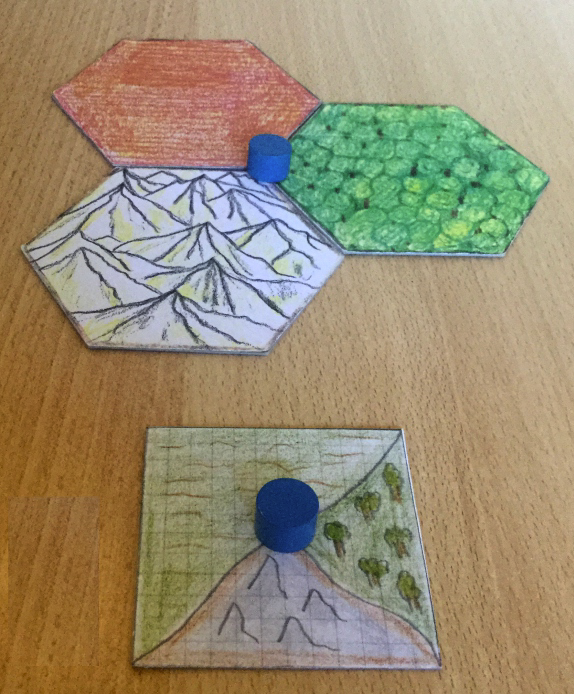
But years before Klaus Teuber had refined and released what was initially titled The Settlers of Catan (and later simply Catan), he was already an established, award-winning designer, considered by some to be one of the finest in his field. And while that field was another of those slim and specific niches, such niches never feel so small to those inside of them. Indeed, when most of a country shares your niche with you, it can feel quite comfortable.
In the Germany of the early 90s, board gaming was already a cultural cornerstone. It wasn’t unusual to find them reviewed in newspapers alongside books and films, and for many Germans they were as common a family pastime as watching television together. Germany hosted board game conventions on a scale the rest of the world still struggles to match today and the infamous Spiel, which takes place every year in the western city of Essen, was already boasting an attendance well over one hundred thousand. In comparison, GenCon, the most established tabletop convention in the US, reached approximately seventy thousand visitors just last year. Spiel tripled that.
And, just like a successful book, an acclaimed board game could sell tens or even hundreds of thousands of copies. Each year, a jury of German-speaking judges came together to decide who would receive the coveted Spiel des Jahres, the winning of which all but guaranteed a tenfold increase in sales. By 1995, Klaus Teuber had already distinguished himself by snagging this award. In fact, he’d won it three times in four years. In spite of this impressive success, he continued to toil in his lab, manufacturing dental implants by day and returning to his latest games designs by night.
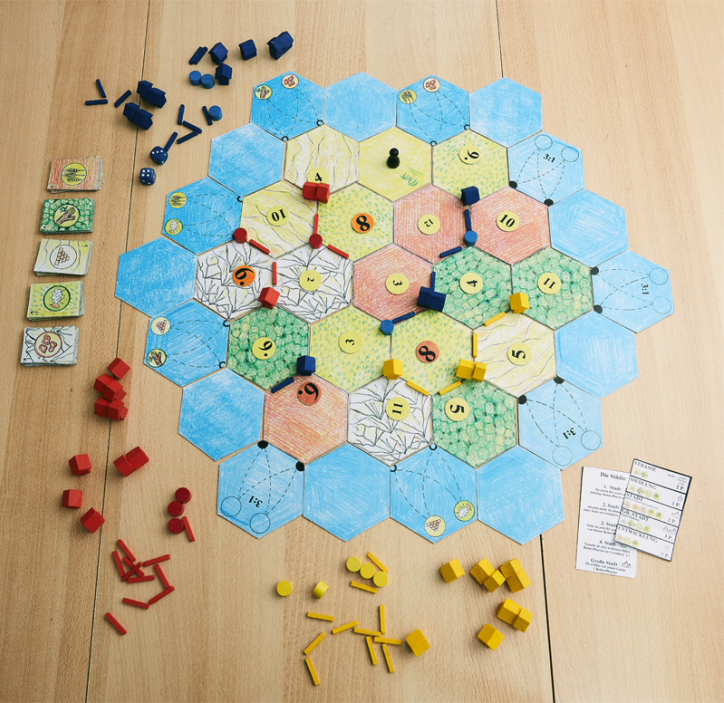
“I had a very hard time in my profession,” he tells me over a Skype call as we cast back to the origins of Catan, and he describes designing games as his “refuge.” The profit margins in board gaming are modest at best and his hobby was never intended to be an escape, but it was certainly something he gave his all. Before Catan, he’d developed a dozen other titles and, after finding success with his clay modelling game Barbarossa in 1988 (his first Spiel des Jahres winner), he experimented with a host of ideas. There was the bluffing game Hoity Toity (1990's Spiel des Jahres winner), the farming game Timberland, the tile-laying game Wacky Wacky West (1991's winner), and even an Asterix game.
Catan was another experiment with new mechanics, combining resource-gathering, economic development and player negotiation. Inspired by tales of Viking explorers and by Klaus’s own interpretation of settlers reaching an empty Iceland in the ninth century, his desire was to make a game with less direct competition and more cooperation. His vision was ambitious and he soon realized his design was far too elaborate. “There was exploring, there were knights, there were cities,” he says. “I realized I had to reduce it to either exploring or to settling.” As its original title suggests, exploring was sidelined.
Substantially streamlined, the game now involved players rolling dice to collect natural resources, which were then used to build roads and settlements across a mostly empty island. With limited access to those natural resources, players were compelled to trade them. As the game progressed and as their settlements grew, opportunities arose for both theft and even territorialism, though any conflict remained strictly economic. Even if it might take time to grasp all the rules, trading and negotiation were things everyone could immediately appreciate and it was only natural for the game to be led by social dynamics and the personalities of its players.
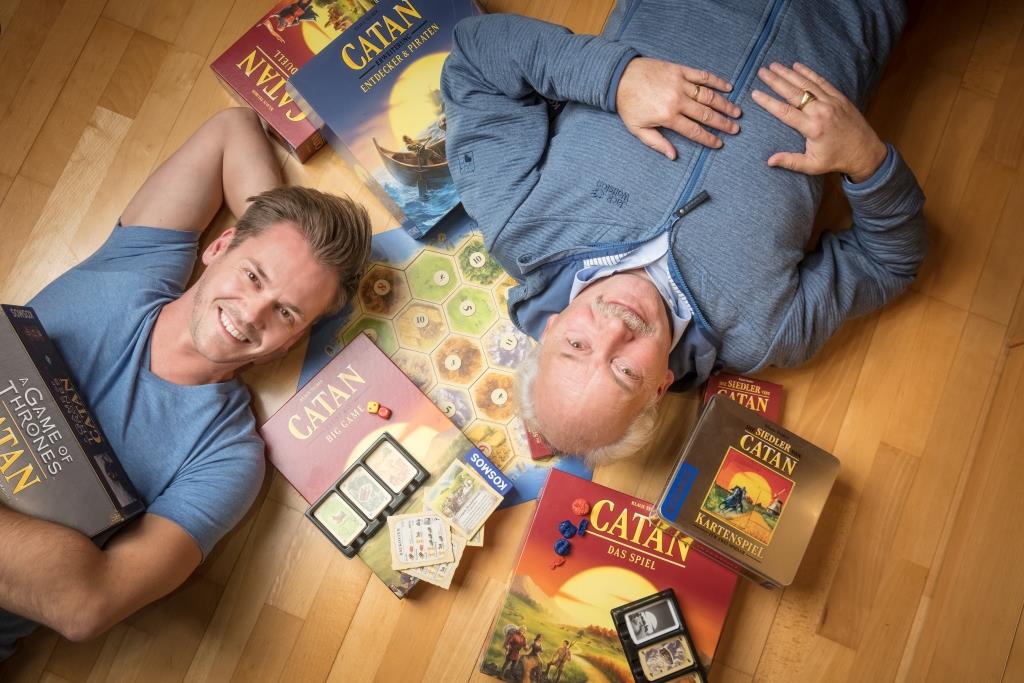
Klaus liked his distilled design and so did his family, who he regularly tested prototypes with, but he certainly didn’t imagine any runaway success. In 1995, Catan became his thirteenth release and he wondered if even this abridged version of his vision was still too much. “When Catan was published, it was one of the more complex games around,” he says, and he lowered his expectations accordingly. He continues with something of an understatement: “People liked it very much, from the beginning.”
Catan received rave reviews in those German newspapers, sold out its first print run at the Spiel convention, sold a further 400,000 copies through 1995 and capped the year by winning Klaus his fourth Spiel des Jahres. Most significantly, while some games might fall out of favor within a year and never see another print run, Catan not only continued selling, it sold in life-changing quantities. Klaus was able to leave his job within three years and become that rarest of hen’s teeth: the full-time board game designer. He began work on expansions that reintroduced the complexities he initially thought too much: a Seafarers expansion added ships and more islands, while a Cities & Knights expansion added more resources and armies that collectively defended players from invaders. Klaus also set up his own business, Catan GmbH, which has been led by family members ever since.
The success only started there. After firmly establishing itself within Germany, Catan began to push out of that national niche to find audiences abroad, even amongst those who’d had no previous interest in board games. Slowly but surely, iIt sneaked its way onto the shelves of shops and department stores that had never stocked anything like it before, gradually building a momentum that it has never lost.
No board game released before or since can chart a comparable trajectory. Understanding exactly how Catan was the title to both break out of Germany and to break into mainstream culture isn’t easy, but the explanation may be found in a collection of gently undramatic factors and subtly smart design decisions. Combined, all of these have played some part in its continued success and first among them must surely be the game’s overarching philosophy of negotiation and compromise.
“People still have their conflicts like in Monopoly or [other board games],” says Benjamin Teuber, Klaus’ son, who shares the Skype call with us. “But they have to solve them through negotiation, trade and cooperation. These are approachable, anti-capitalistic ideas.” One of those family testers, Benjamin now handles Catan’s marketing, and he believes many players appreciate a gentler, more interpersonal alternative to the cutthroat play of Monopoly or the brooding silence of Chess. Catan asks players to be deal-makers and diplomats, which can bring out a new side of them. “We say that you get to know someone in one hour of gaming more than you will in many hours of regular life.”
Both Klaus and Benjamin also describe a kind of evangelical attitude that spread amongst early Catan players, a sort of tabletop word-of-mouth. Many new players never read the rules because they were taught the game by someone else, who themselves may have been similarly tutored, and this is because the genius of Catan is in how it is built upon the familiar.
“Simplicity and recognizable mechanics have contributed enormously to Catan’s success,” says AnnaMaria Jackson-Phelps, board game critic and editor of Girls’ Game Shelf. “Even for people that haven't played games in years, actions like rolling dice, trading resources and building mimic the games of our youth.” Similarly, she explains how a lack of language dependence “allows it to cross generations as well as international boundaries.” Compared to the text-heavy board and cards found in Monopoly, Catan is mute, clear and colourful.
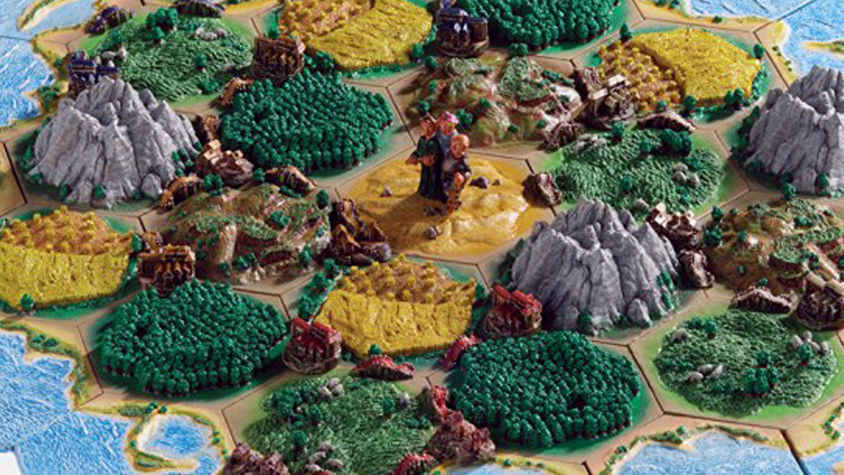
Indeed, contemporary board game designer Elizabeth Hargrave (herself the winner of the Connoisseur award at the 2019 Spiel des Jahres) points out that Catan’s “complex” core rules fill just two pages and that so many of the familiar concepts in the game are ones that feel positive, rewarding and encouraging. “Trading is a highly social activity that leaves many players with a win-win feeling after,” she says. “People like to build things [and] Catan gives you a good sense of forward progression - the stuff you build stays on the board and grows. Rolling dice to generate resources gives a sense of anticipation and excitement - and it gives you an external force to blame when you don't do well.”
Furthermore, Catan’s hexagonal landscapes hide intriguing possibilities. Unlike Monopoly, Cluedo or Scrabble, Catan’s board doesn’t need to be the same every game. Each of its nineteen hexes is an individual piece, making for a geographical jigsaw that presents 244,432,188,000 possible combinations. This simple design decision means that, if you don’t like how the last game of Catan went, the next one can be completely different. Even in today’s crowded landscape, where more than 3,000 board games are released a year, it’s rare for one to offer such boundless possibility.
Catan’s astronomical sales figures also mask a more modest truth. While it was an immediate success in Germany, its global penetration has been more gradual. It wasn’t until the mid 2000s that its North American sales came anywhere close to matching those of its first year in Germany and not everyone in overseas territories was immediately won over by what has come to be called “German-style” board games, or “Eurogames.” These economy-driven, low-conflict experiences were almost the direct opposite of wargames, Dungeons & Dragons and the head-to-head battles of Magic, all of which also enjoyed continued growth. Catan had to earn its time at the games table, but there was no doubt that it arrived just as players were finding more excuses to spend time at that table and enjoy what Benjamin calls “a digital detox.”
Twenty-five years on, the tabletop games market of 2020 is still a curious place. While much has changed, much also remains the same. Benjamin tells me that Catan series’ sales are now around the thirty million mark, which is extraordinary for a German-style game and all but assures that Catan hasn’t just won its spot at the table, but is becoming as dependable as presence as Monopoly, Scrabble or any of their ilk. Hargrave describes it as reaching “critical mass” and as a new “common denominator.” It now graces the shelves of major retailers, department stores and even bookshops.
“Cultural consciousness keeps Catan relevant,” agrees Jackson-Phelps. “We still see it pop up in media that crosses genres… It’s become shorthand for our hobby.” That shorthand has been featured on shows like The Big Bang Theory and Parks and Recreation, and the Catan catalogue has grown to include an impressive array of spin-offs and expansions which include major licences such as Star Trek and Game of Thrones, both of which tempt more new players with their relatable franchises. Every two years, a Catan World Championship is played and it invariably showcases how far the game has travelled. 2018’s final saw Mexican Quetzal Hernandez beat Columbian José Miguel Ferrario Parrado, while the top 20 finalists represented four different continents.
It has also helped spearhead a tabletop revolution and in its wake thousands more board games have saturated that rapidly expanding niche: those 3,000 releases a year. Designer Jenn Sandercock describes Catan as “The most well known frontrunner to the modern tabletop games industry,” and the industry that has grown behind it is remarkably industrious. Some of those 3,000 releases will also be based around economy-building or trading, but many others feature everything from elaborate bluffing and intrigue to simple dice-rolling and set collection. A growing body of designers tries to satisfy an equally expansive and often voracious audience, creating a spectrum of games so diverse in complexity and style that, in comparison, Catan’s two page core rules can seem all but Lilliputian or horrendously overwrought.
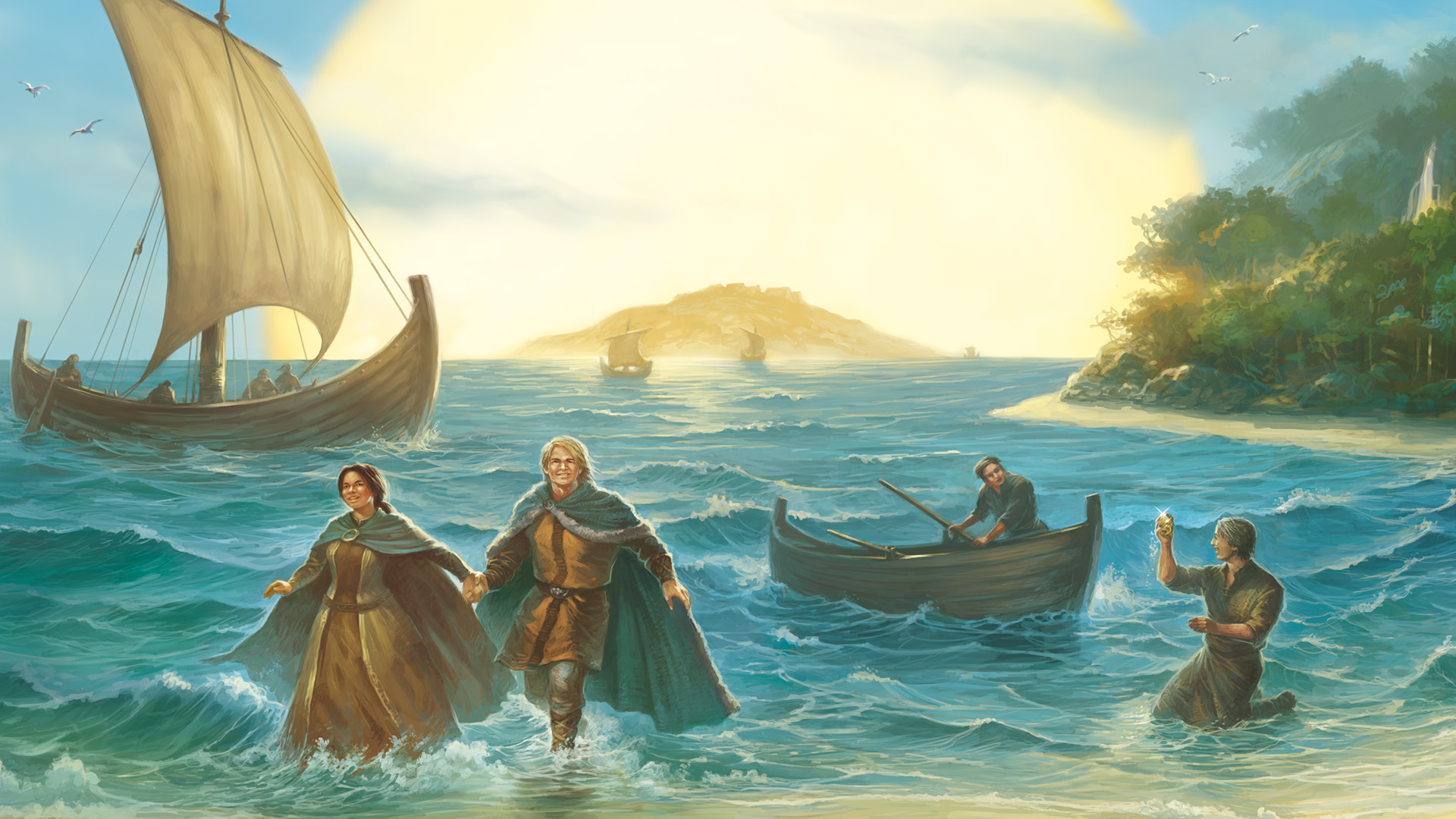
Yet thirty million sales remains small change against Monopoly or Scrabble, which have sold ten and five times as many copies respectively. Even Trivial Pursuit boasts sales in the hundreds of millions and Cluedo shifts around three million copies a year. Catan is their baby brother, a remarkable exception that has surged beyond a still relatively narrow niche. It’s a bridge back to a scene where profit margins remain slim, audiences are much smaller and many designers continue to live lives like Klaus once did: as part-time hobbyists propped up by a day job, sharing the aphorism “To make a little money in board games, you first have to spend a lot.” Most of those 3,000 releases will only see small print runs of a few thousand and won’t experience a second edition. Many will quickly lose relevance as new designs and trends overtake them
Curiously, within that niche Catan itself is sometimes seen as no longer relevant, long having sailed from this hungry, hobbyist realm to enjoy the calmer waters of the mainstream. Indeed, the very surge it has lead might well overwhelm it today. “If it came out now it would probably be overlooked,” says Sandercock. “It doesn't really have enough of a hook or something to stand out in a crowded market. I think it endures because [the designers] have continued to come up with new variations of the core game.”
At the same time, there’s also a small but growing dissatisfaction with board games based around colonising territory or exploiting natural resources, something that has been a common topic for many. “If I stop and think about the theme for even a second, I really don't want to be modelling landing in some new continent and stripping out all the natural resources,” says Hargreave. “Catan is far from being the only board game that does this, but there are so many other things that games could be about. That's why I started designing.”
It would be gauche to say that Catan doesn’t need the support of hobbyist gamers any more, but that ongoing momentum suggests another twenty-five years of success. By then, its sales figures may truly be comparable to the giants of old, and perhaps also the same contempt some hold for overfamiliar holiday board games. For the Catan team, the future will remain familiar, and while they’re interested in expanding their catalogue further, they intend to stand by that same core philosophy of trading, cooperation and economic progress (even their Game of Thrones tie-in is remarkably lacking in intrigue, infanticide or incest). The future is also digital, however, and after a slew of apps and adaptations, the augmented reality game Catan - World Explorers is now being developed by Niantic, creators of Pokémon Go.
Klaus, meanwhile, doesn’t seem too fazed by all the success, nor by the idea that people all around the world are now playing his very lucky thirteenth release. “I don’t reflect on that so much!” he laughs. “This is not something I think about.” Instead, he still devotes his time to ongoing design work, his family handling much of the business and marketing. It’s design that was his refuge and it’s design that remains his passion. Passion, he says, might be the secret ingredient, and it’s his only suggestion to how you devise the next multi-million selling board game.
“Everything you do, if you paint a picture, if you write a novel or if you design a game, what you need behind it is passion,” he concludes, at the end of our call. “If you have passion, I think you have a chance. Don’t think first about money and success. This is the only answer I can give you.”
from VICE https://ift.tt/2YnELwl
via cheap web hosting
No comments:
Post a Comment